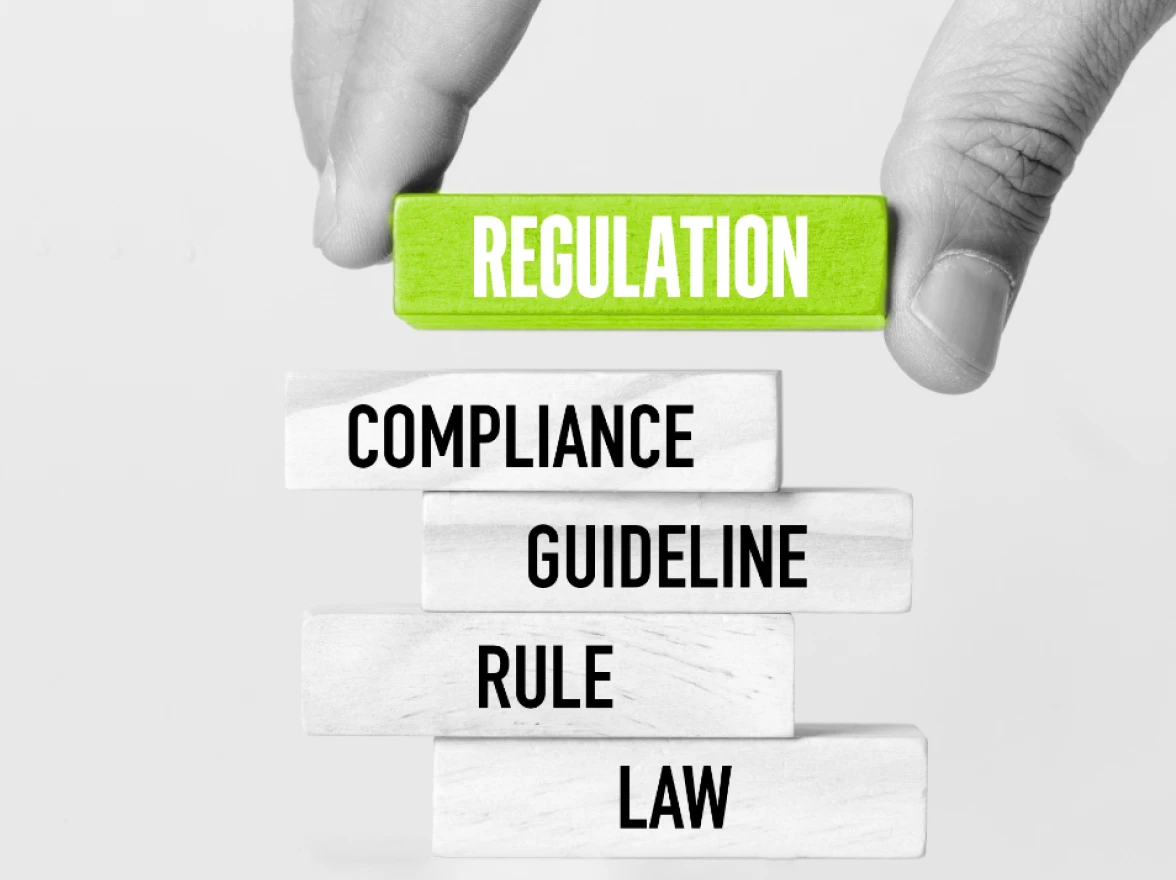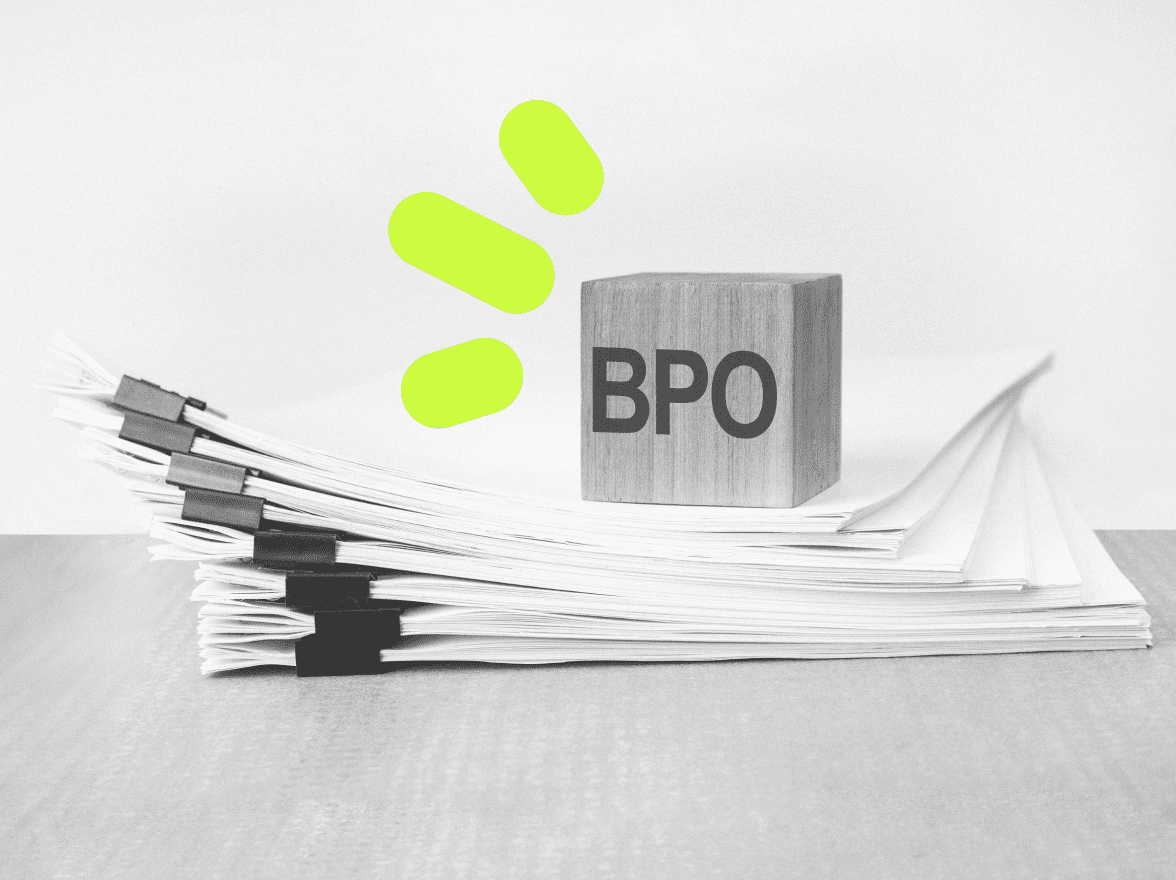The best call center is like the Swiss Army knife – it started with one blade (the good old phone lines), and it developed into something so much more. Today, call center software is a digital solution that helps businesses manage customer interactions across multiple channels, from traditional phone calls to modern digital touchpoints. As customer service expectations continue to rise, companies can no longer rely on phone-only support. Instead, the evolution has been clear: Phone → Omnichannel → AI-powered.
Early call centers handled just inbound calls, but today’s best systems integrate chat, email, social media, and self-service tools to deliver a fantastic customer experience. By centralizing these channels, call center software not only improves efficiency but also helps agents to provide faster, smarter, and more personalized support. It is 2025, after all; no one likes to be on hold with elevator music unless it’s the music from The Nutcracker.
All jokes aside, what makes the call center software solution the best? Let’s find out.
Key takeaways
- Improve efficiency by automating repetitive tasks, reducing call handling times, and increasing overall customer satisfaction.
- Use AI to power smart call routing, predictive insights, and virtual assistants that enhance both agent productivity and customer interactions.
- Enhance CRM integration to provide agents with instant access to customer data, ensuring personalized and consistent support.
- Offer omnichannel solutions that connect phone, live chat, email, and social platforms in one interface for seamless communication.
- Optimize workforce management with tools for scheduling, monitoring, and performance tracking to maintain optimal call center operations.
15 best call center software
Finding the right call center software can transform how businesses manage customer interactions, improving the overall efficiency across every channel. To help you choose, we’ve compared the top center solutions in 2025 based on pricing per month, features, and per active user feedback, along with the key criteria we used to evaluate them.
| Platform | Starting price | Dialer modes available | Analytics | Best for | G2 rating |
|---|---|---|---|---|---|
| MightyCall | $20/month | Power, Preview, Predictive | Advanced | Small to medium-sized teams that need affordability | 4.4/5 |
| Dialpad | $27/month | Power, Preview | AI-driven analytics | Businesses seeking AI + UC integration | 4.4/5 |
| ViciDial | Open source | Predictive, Progressive | Customizable | Tech-savvy teams needing flexibility | 4.1/5 |
| RingCentral | $30/month | Progressive, Predictive | Custom & real-time | Unified communications + scalability | 4.1/5 |
| ReadyMode | $199/month | Predictive | Advanced performance | High-volume outbound calling | 4.6/5 |
| Kixie | Request a quote | Preview | Sales-focused reports | Sales teams that need automation | 4.8/5 |
| Aircall | $40/month | Power, Preview | Real-time dashboards | SMBs needing fast deployment | 4.4/5 |
| 8×8 | Request a quote to find out the pricing per month | Progressive, Predictive | Comprehensive analytics | Global companies that need reliability | 4.2/5 |
| CallHippo | $0/month | Power, Parallel, Predictive | Standard analytics | Budget-friendly startups | 4.4/5 |
| CloudTalk | $27/month | Power, Parallel | Real-time + historical | SMBs with international reach | 4.4/5 |
| JustCall | $39/month | Predictive, Power | Sales + support KPIs | Teams blending sales & support | 4.3/5 |
| Ringover | $29/month | Power, Parallel | Customizable dashboards | Teams needing collaboration features | 4.6/5 |
| Vonage | Request a quote to find out the pricing per month |
N/A | Standard & advanced | Enterprises with global operations | 4.3/5 |
| NICE | $71/month | N/A | Enterprise-grade | Large enterprises with compliance needs | 4.3/5 |
| Five9 | $119/month | Auto | AI + real-time reports | Enterprises needing a bigger scale | 4.1/5 |
Evaluation criteria we considered:
- Ease of use: How intuitive the center solution is for agents and managers.
- Scalability: Ability to grow with call center size and complexity.
- Feature depth: Availability of advanced tools like AI, live chat, and integrations.
- Analytics and reporting: Convenience of dashboards, KPIs, and insights.
- Value for money: Balance of pricing with offered features.
What is call center software?
Call center software is a system that allows businesses to manage inbound and outbound phone calls, customer support, and communication workflows through dedicated programs or cloud-based platforms. It improves agent productivity by automating call distribution, tracking interactions, and centralizing customer data. These programs typically connect with telephony technologies such as PBX (Private Branch Exchange) and VoIP, making them essential for both on-premise and virtual call center systems.
Modern call center software goes beyond handling automatic call routing. It offers features like call recording, CRM integration, and real-time analytics to optimize performance and ensure consistent customer experiences. By consolidating multiple tools into a single center solution, these systems help organizations to organize support, improve efficiency, and deliver more personalized service throughout every stage of customer communication.
Types of call center software
Call center systems come in different forms, each designed to support specific business needs, from managing inbound calls to handling outbound campaigns or enabling agents to work remotely. Any modern call center solution prioritizes scalability, workforce management, and seamless integration with digital channels, including email, live chat, and social media. Below are the main types of call center software commonly used by organizations today.
- On-premise call center systems: Installed on company servers with full control over hardware and security. Example: enterprise-level support centers needing strict compliance.
- Hosted call center solutions: Delivered through a service provider’s infrastructure, reducing IT maintenance. Example: mid-size businesses seeking scalability without heavy setup costs.
- Virtual call centers: Cloud-based platforms that allow agents to work from anywhere. Example: remote teams managing global customer bases across time zones.
- Inbound call center software: Built for managing incoming requests such as customer support hotlines or help desks. Example: a retail brand’s helpline for product inquiries.
- Outbound call center software: Focused on proactive outreach with tools like predictive dialers for call center operations and campaign tracking. Example: sales teams running telemarketing or follow-up campaigns.
Key features to look for in software for call centers
When choosing the best call center software, it’s important to focus on features that improve efficiency and customer satisfaction. Look for tools that support automatic call routing, CRM integration, call recording, and advanced analytics. Supervisor tools like real-time monitoring and reporting are also essential for performance tracking, while scalability ensures the system grows with your business needs.
Automatic call distribution and IVR in call center software
In call center software, Automatic Call Distribution (ACD) is the system that routes incoming calls to the right agent based on predefined rules such as skills, availability, or priority. Interactive Voice Response (IVR) is the self-service menu that lets callers navigate options using voice commands or keypad selections before being routed. Together, these tools reduce wait times and improve customer satisfaction by ensuring each call reaches the right department or agent quickly.
AI, analytics, and performance management
AI-powered dashboards in modern call center solutions offer managers real-time insights into critical KPIs, such as average handle time (AHT), first-call resolution, and abandonment rates—via intuitive charts and visual alerts. These tools support workforce management by highlighting peak call volumes, agent occupancy, and performance trends. AI-driven agent assistance, from automated call routing to after-call documentation, has been shown to reduce handling time by up to 40 % while significantly decreasing agent workload.
CRM integration and telephone data processing
Effective CRM integration in call center solutions ensures agents have a single, unified view of customer interactions across every telephone call, email, or chat. This reduces data silos, improves personalization, and speeds up resolution times. By combining call logs with CRM records, companies can track the entire customer journey and provide context-rich support.
Key benefits of using CRMs for call centers:
- Access to complete customer history during live calls.
- Faster resolution through pre-filled data and notes.
- Improved cross-team collaboration with centralized records.
- Enhanced reporting by linking communication data with sales/service outcomes.
Dashboards, reporting, and quality assurance programs
Some of the best call center software solutions offer real-time dashboards and quality assurance programs that enable supervisors to monitor agent performance and enhance service quality. Dashboards visualize key KPIs such as call volumes, wait times, and average handle time, helping managers to identify issues as they occur. QA programs often include call recording and post-call evaluations, creating feedback loops that boost both compliance and customer satisfaction.
Standard reports include:
- Call volume and traffic trends.
- Agent performance and productivity metrics.
- Customer satisfaction and resolution rates.
- Quality monitoring and compliance results.
Security, compliance, and SLA guarantees
In today’s environment, call center software must prioritize data protection, regulatory compliance, and reliable uptime. Strong security measures ensure customer information is safeguarded across all systems, while compliance with industry regulations builds trust and avoids penalties. An SLA (Service Level Agreement) is a formal contract between the provider and client that guarantees specific service standards, such as system uptime, response times, and data recovery commitments.
Key compliance standards to look for:
- GDPR: Protects personal data for EU customers.
- HIPAA: Ensures healthcare-related information security.
- PCI DSS: Secures payment processing and credit card data.
- SOC 2: Verifies strong controls for data security and privacy.
By following and aligning with these standards and ensuring SLA guarantees, businesses can deliver secure, uninterrupted customer service with confidence.
Top call center software platforms and solutions: Overview
Choosing the best call center software means considering how each call center solution meets your needs, whether for digital channels, customer support, sales outreach, or enterprise-level reliability. Below is an overview of the leading platforms that we picked out. Let’s have a closer look at each.
1. MightyCall
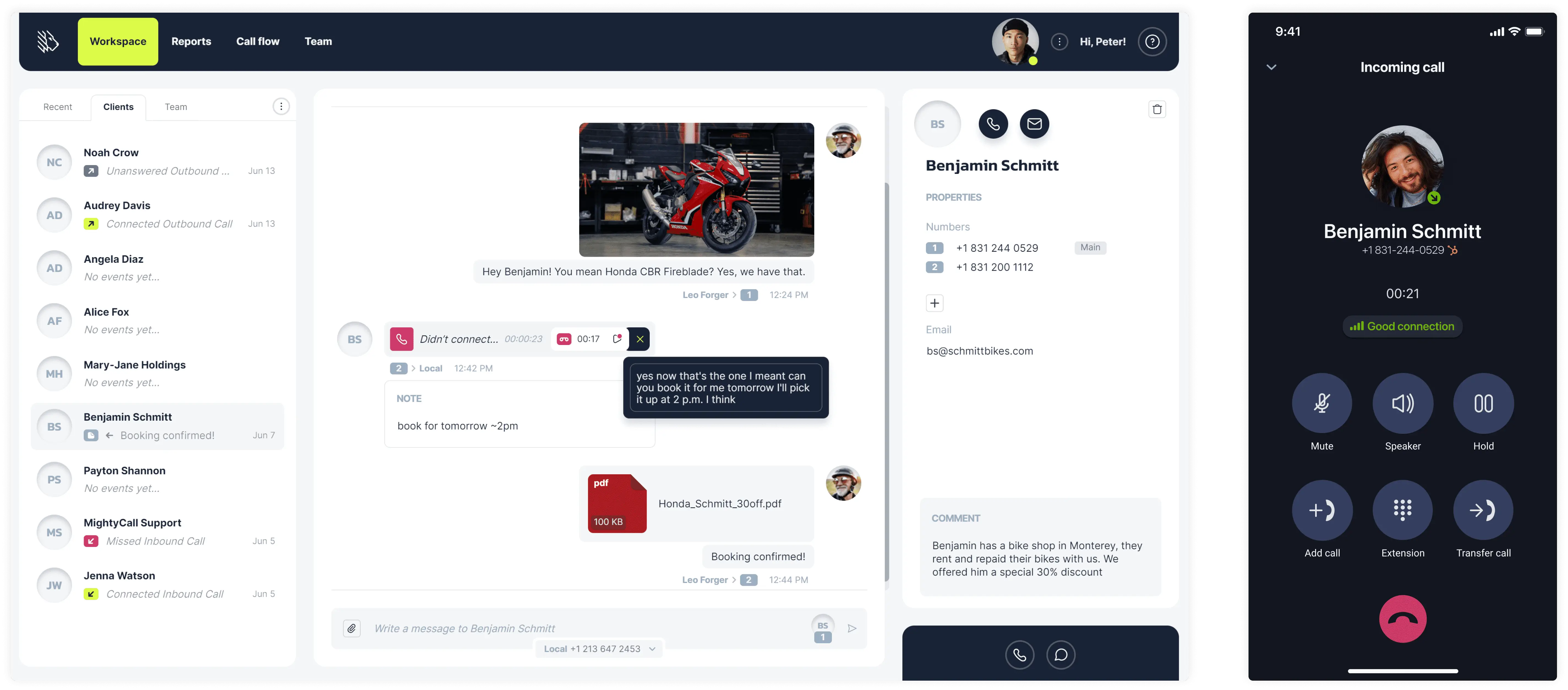
MightyCall is a cloud-based call center software designed for small to medium-sized businesses, offering an intuitive interface and essential features like call routing, voicemail transcription, and CRM integration. Users appreciate the affordability and ease of setup, making it ideal for businesses without extensive IT resources. However, some users note limitations in advanced analytics and reporting features. With a G2 rating of 4.4/5, MightyCall is recognized for its reliable performance and exceptional customer support.
Key features:
- Auto dialer
- Multi-level IVR
- Call recording
- Voicemail to text transcription
- CRM integrations
- Call monitoring tools
- Auto attendant
Best for: Small to medium-sized businesses seeking a cost-effective and user-friendly call center solution.
Strengths: Affordable pricing, intuitive interface, smooth CRM integrations, and strong customer support.
Limitations: Missing video conferencing.
schedule your personalized demo with our amazing team

2. Dialpad
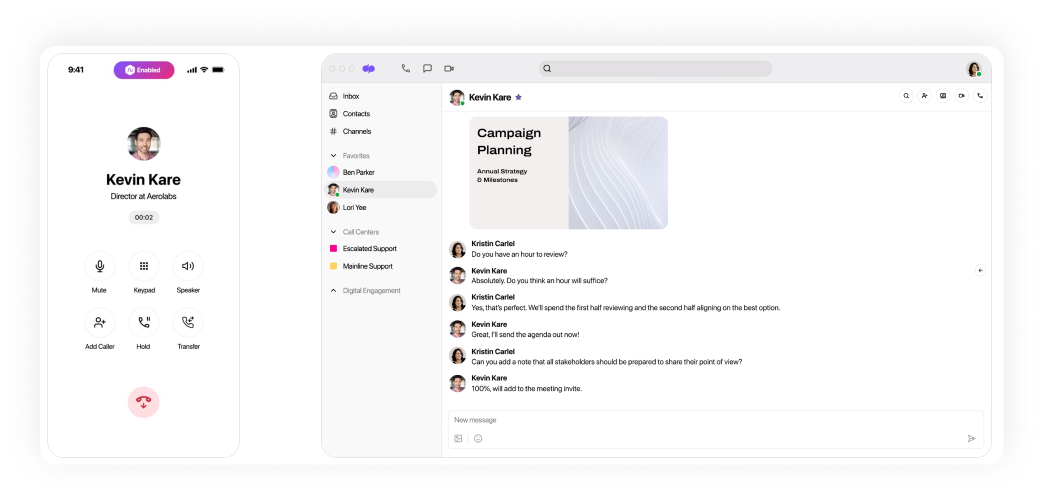
Dialpad is a cloud-based call center software built with AI at its core, making it a strong fit for enterprises and mid-sized businesses that handle both inbound and outbound communications. Users consistently highlight its AI-powered features as major productivity boosters. With a G2 rating of 4.4/5, it is praised for being intuitive and easy to integrate with CRMs. However, some users mention occasional call drops and a learning curve when configuring more advanced features, such as IVR.
Key features:
- AI-driven real-time transcription
- Sentiment analysis
- Unified voice, messaging, video, and chat
- Post-call analytics
Best for: Enterprises and tech-forward teams seeking AI-powered insights to improve agent performance and customer support.
Strengths: A base of advanced AI tools, strong CRM integrations, a user-friendly setup, and reliable uptime.
Limitations: Occasional call quality issues, learning curve for advanced setup.
3. ViciDial
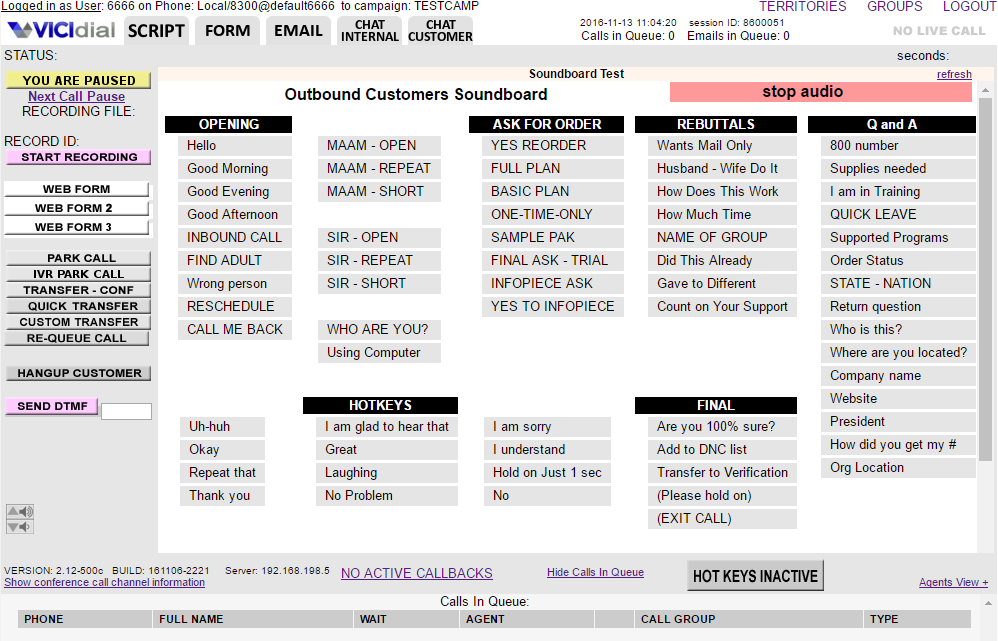
ViciDial is a free, open-source call center software widely used for outbound campaigns, especially by businesses with technical resources. It’s best suited for teams that prioritize flexibility and cost savings over simplicity. With a G2 rating of 4.1/5, users appreciate its ability to handle large-scale dialing and its adaptability to custom workflows. However, many note that it requires strong IT expertise to set up and maintain, and its interface can feel dated compared to modern SaaS platforms.
Key features:
- Predictive, progressive, and manual dialing modes
- Call routing
- Queue management
- CRM integrations
- Open API support
Best for: Outbound-focused businesses that want flexibility without high software costs.
Strengths: Free and highly customizable, strong outbound dialing tools, and scalability for large call volumes.
Limitations: Steeper learning curve, dated UI, heavy reliance on technical expertise.
4. RingCentral
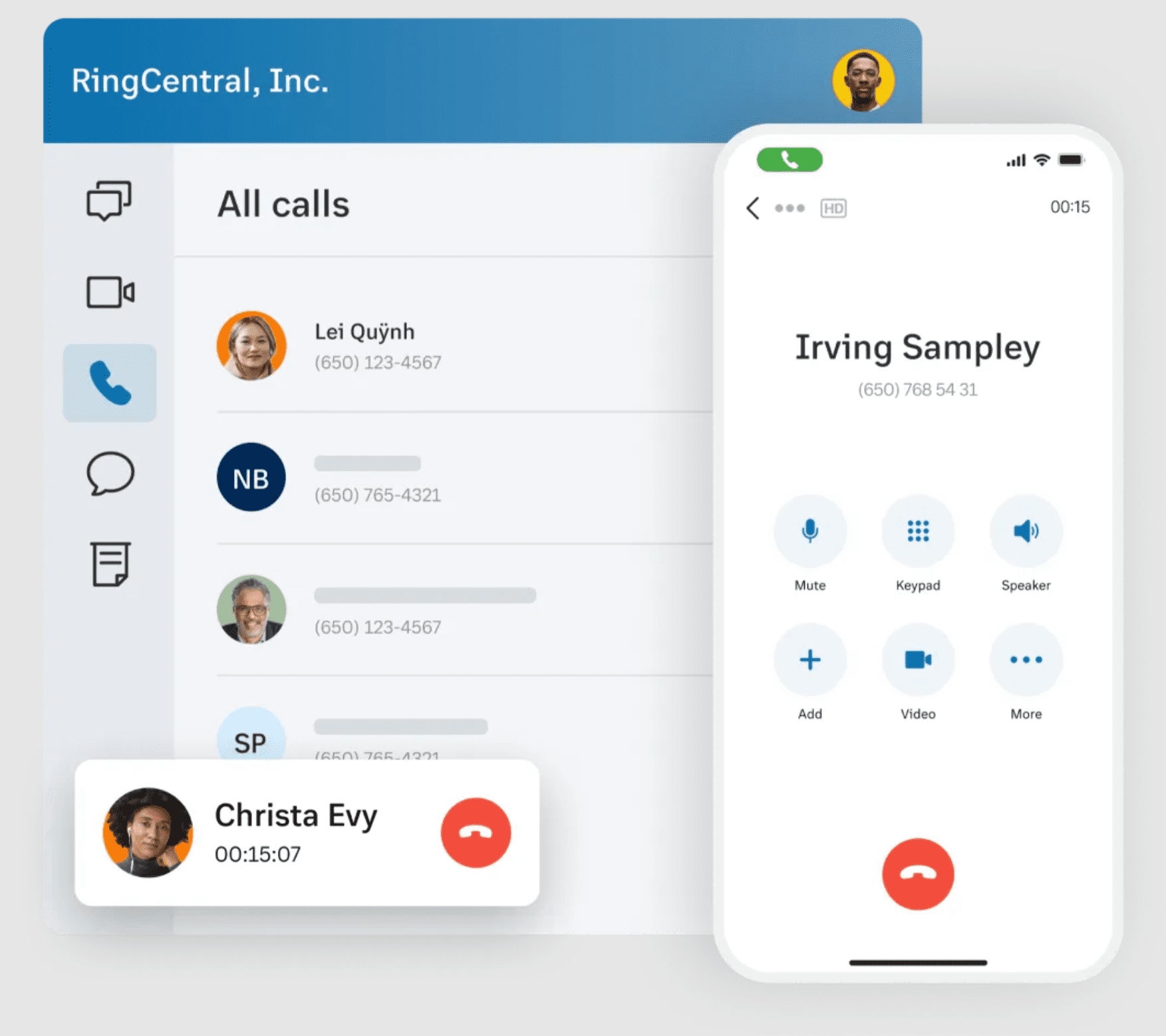
RingCentral offers one of the most feature-rich call center software solutions, making it a great option for mid to large enterprises. It combines traditional call center phone system service with omnichannel communication across email, chat, and social media. With a G2 rating of 4.1/5, users commend its scalability, workforce engagement tools, and integration ecosystem. On the downside, some reviews mention higher costs and a complex setup for advanced features.
Key features:
- Omnichannel support (voice, chat, email, social)
- Intelligent Virtual Agents
- AI tools
Best for: Mid to large businesses that need omnichannel customer support with advanced AI capabilities.
Strengths: Rich feature set, enterprise scalability, strong analytics.
Limitations: Premium pricing, complex implementation.
5. ReadyMode
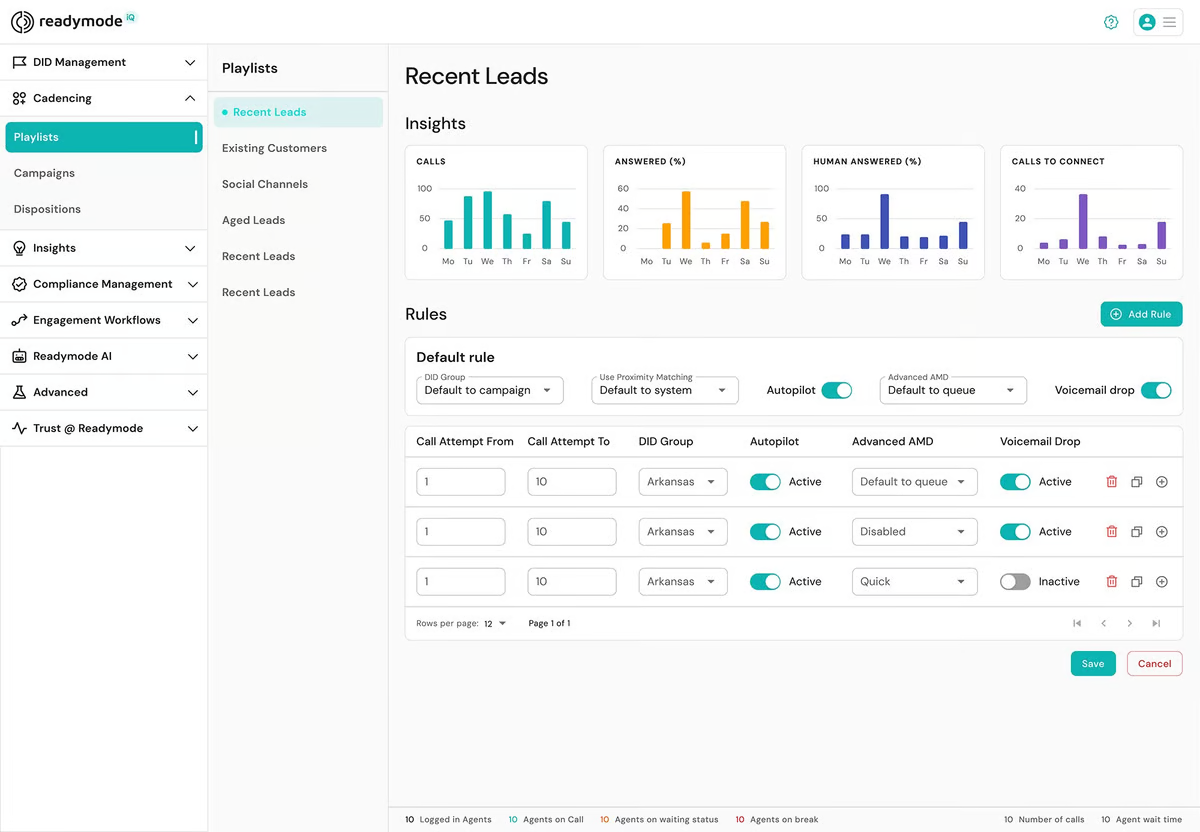
ReadyMode is designed for outbound sales operations that need to maximize calling efficiency. Its predictive dialer and lead management tools help boost productivity for sales-driven teams. With a G2 rating of 4.6/5, users highlight improvements in call volume and lead conversions. However, some note that customization options are limited compared to open-source solutions like ViciDial.
Key features:
- Predictive and auto-dialing
- Built-in lead management tools
- Real-time dashboards
- Call monitoring
- Call recording
Best for: Supports high-volume outbound sales teams that want efficiency and CRM integration.
Strengths: A strong predictive dialing feature, sales-focused workflows, and a user-friendly interface.
Limitations: Less flexible customization, outbound focus only.
6. Kixie
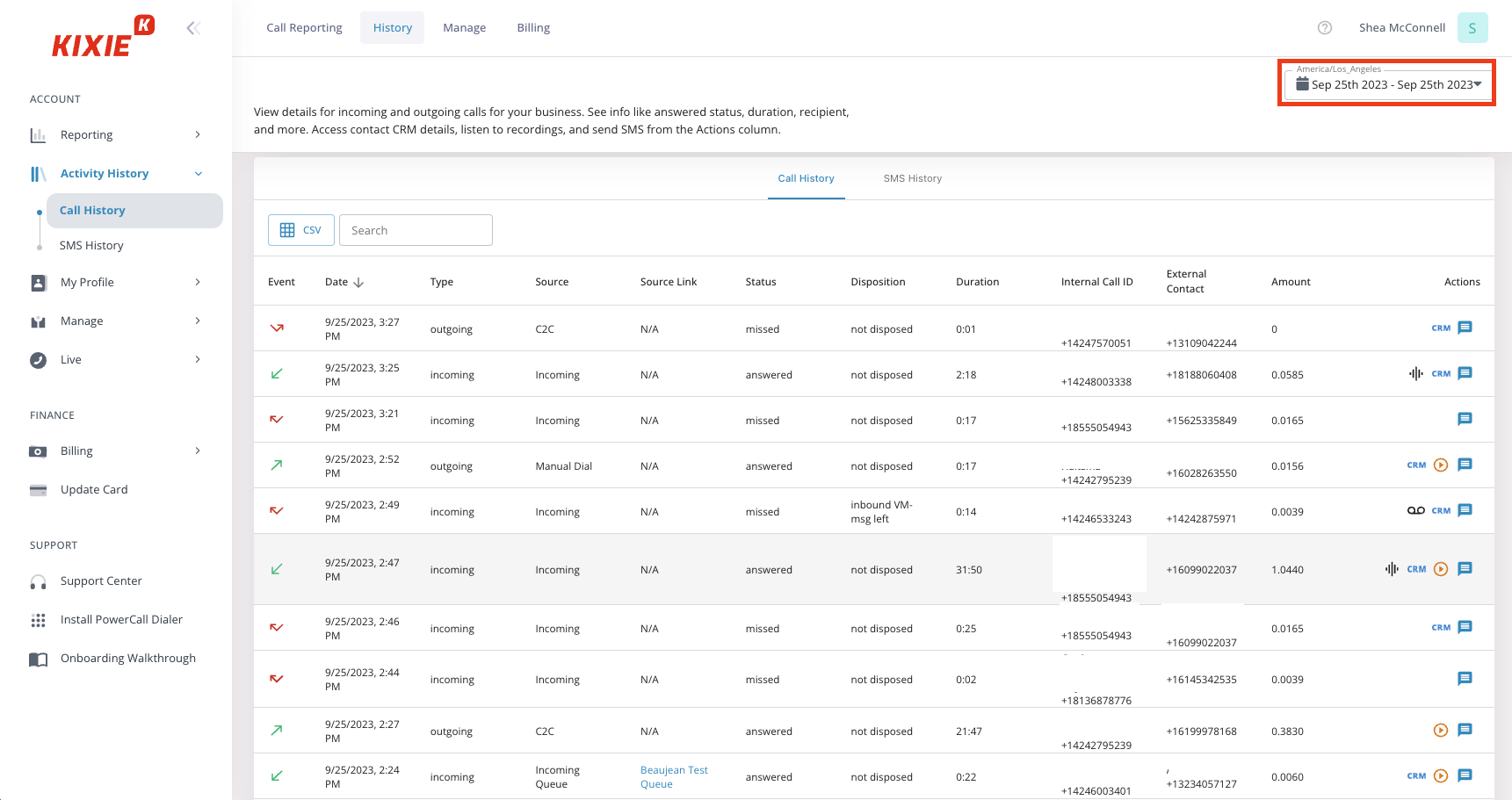
Kixie is a call center software tailored for sales organizations, offering auto-dialing and seamless CRM integrations. It’s best suited for SMBs and mid-market sales teams that prioritize speed and automation. With a G2 rating of 4.8/5, users praise its easy setup, click-to-call functionality, and strong CRM sync (HubSpot, Salesforce, Zoho). However, some report minor call stability issues and limited reporting depth.
Key features:
- SMS automation and tracking
- Click-to-call from any CRM or web application
Best for: They have a strong base for SMB and mid-market sales teams that rely on CRM-driven workflows.
Strengths: Simple to use, strong CRM integration, boosts outbound productivity.
Limitations: Limited analytics depth, occasional call stability issues.
7. Aircall
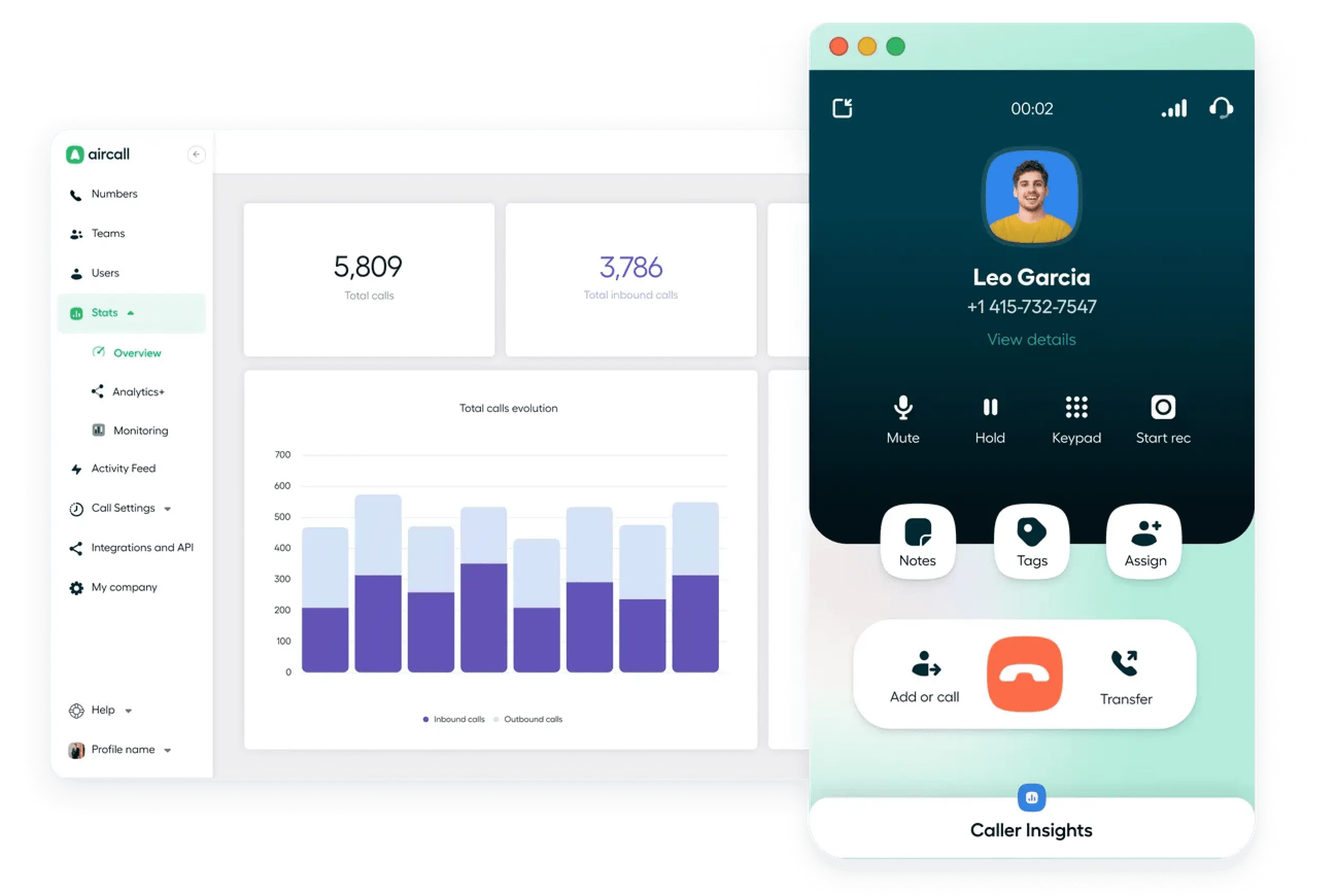
Aircall provides a modern cloud-based phone system with strong collaboration features, making it popular among growing teams and enterprises. With a G2 rating of 4.4/5, users like its intuitive interface, quick setup, and integrations with over 100 tools like Salesforce, Slack, and HubSpot. On the other hand, some users mention call quality issues during peak usage and higher costs compared to leaner tools.
Key features:
- Strong CRM integrations
- Call recording
- Call monitoring
- Advanced analytics
Best for: Growing companies that need flexibility and collaborative tools for distributed teams.
Strengths: Fast setup, broad integrations, great for teamwork.
Limitations: Pricier than some competitors, with occasional call quality issues.
8. 8×8
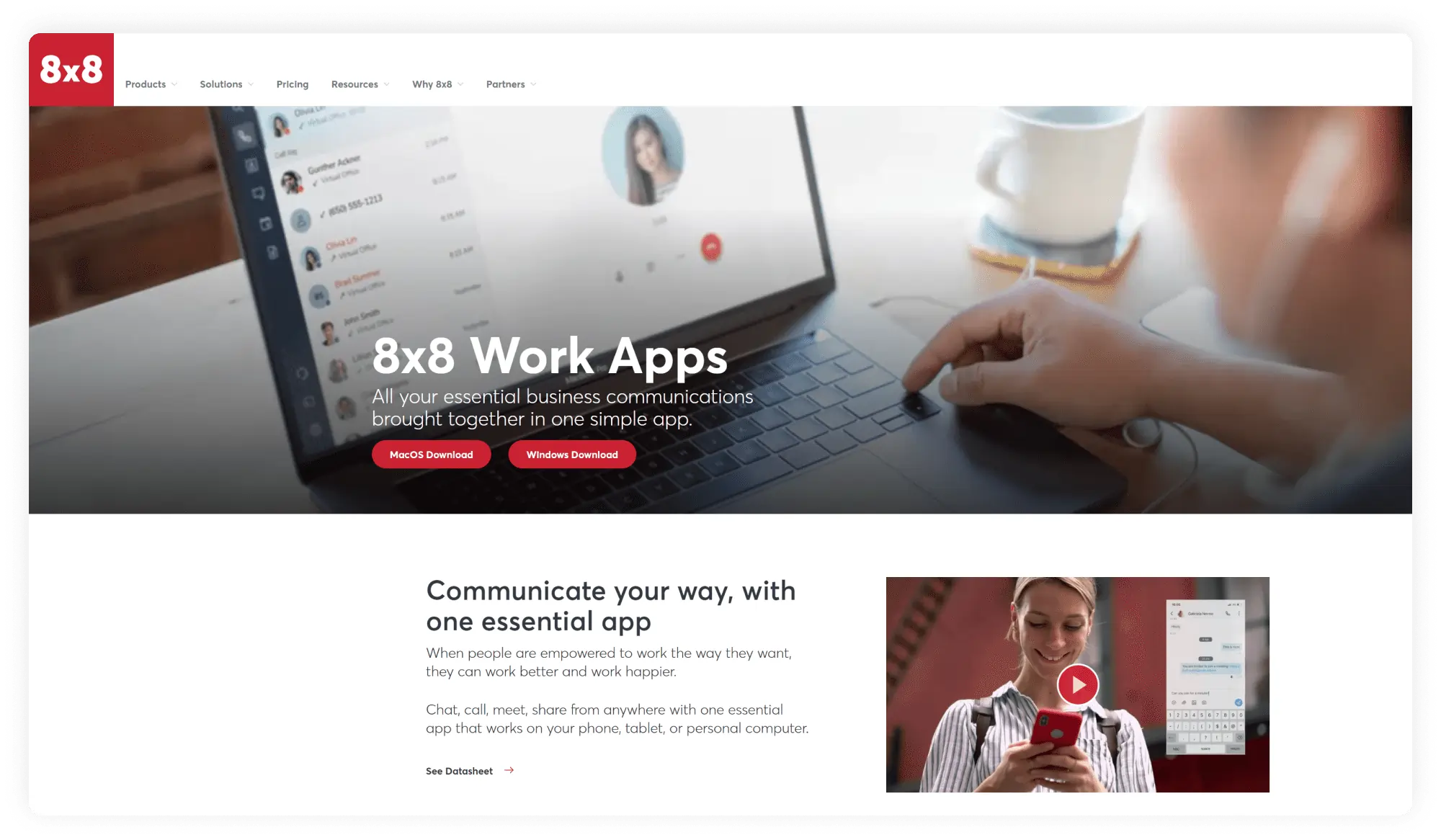
8×8 is an enterprise-grade call center solution offering voice, video, chat, and contact center tools in one package. It’s well-suited for larger organizations that need robust omnichannel capabilities and AI-powered insights. With a G2 rating of 4.2/5, users appreciate the scalability, Conversation IQ analytics, and international coverage. However, some users cite inconsistent customer support and occasional reliability issues.
Key features:
- Omnichannel communication (voice, chat, video, SMS)
- AI analytics
- Quality monitoring
Best for: Large enterprises with international operations and omnichannel needs.
Strengths: Advanced analytics, strong global coverage, enterprise scalability.
Limitations: Mixed customer support reviews, reliability fluctuations.
9. CallHippo
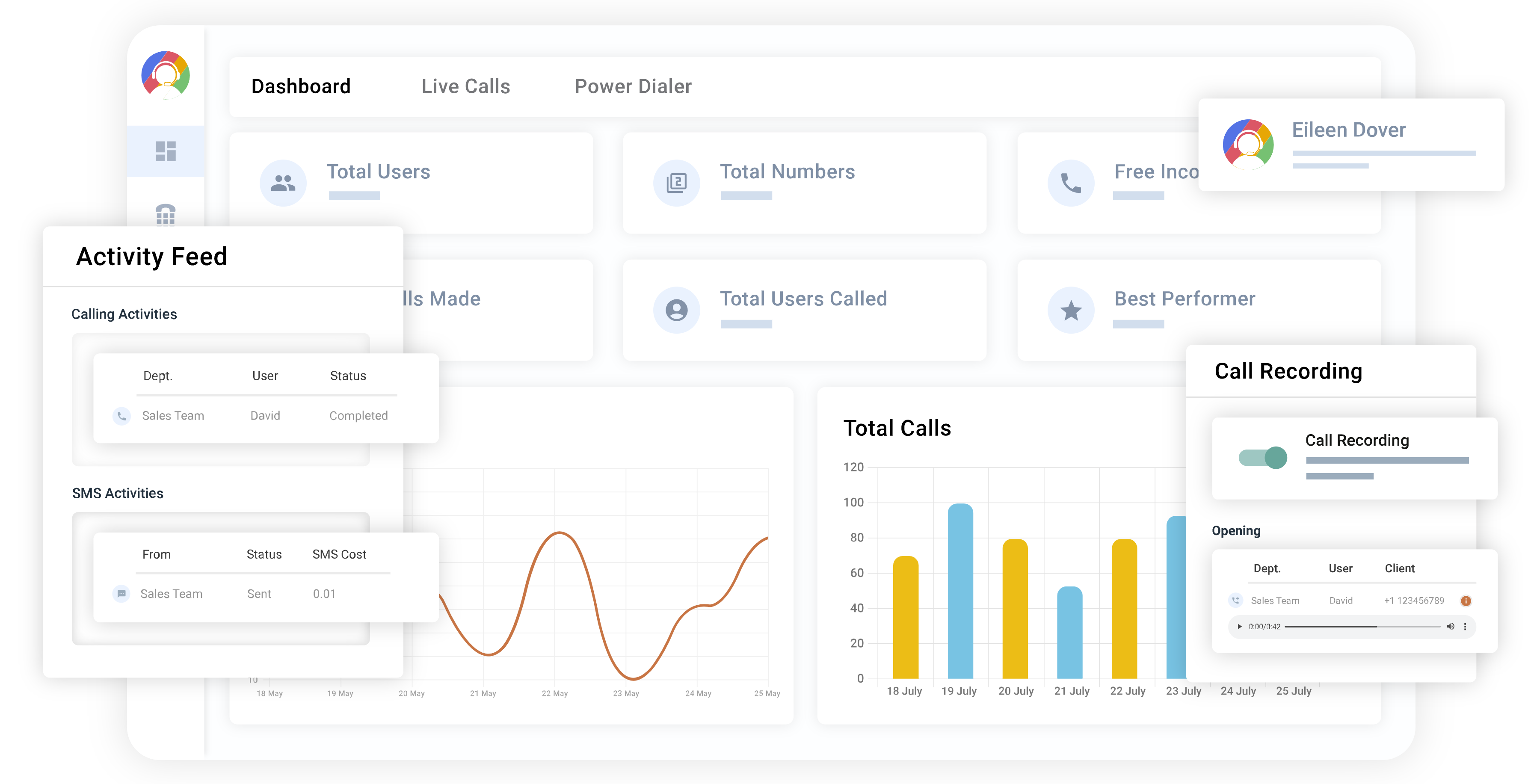
CallHippo specializes in VoIP-based communication, making it a strong fit for companies that want affordable, flexible, and global phone solutions. With a G2 rating of 4.4/5, users appreciate its affordability, intuitive interface, and unique features like email tagging. On the downside, reviews mention limited reporting tools and fewer advanced call center capabilities compared to enterprise platforms.
Key features:
- Email tagging
- Call notes
- Call forwarding, recording, and monitoring
- Real-time analytics dashboard
Best for: SMBs looking for affordable VoIP solutions.
Strengths: Cost-effective, easy to set up, and unique tagging features.
Limitations: Limited analytics and fewer enterprise-grade features.
10. CloudTalk
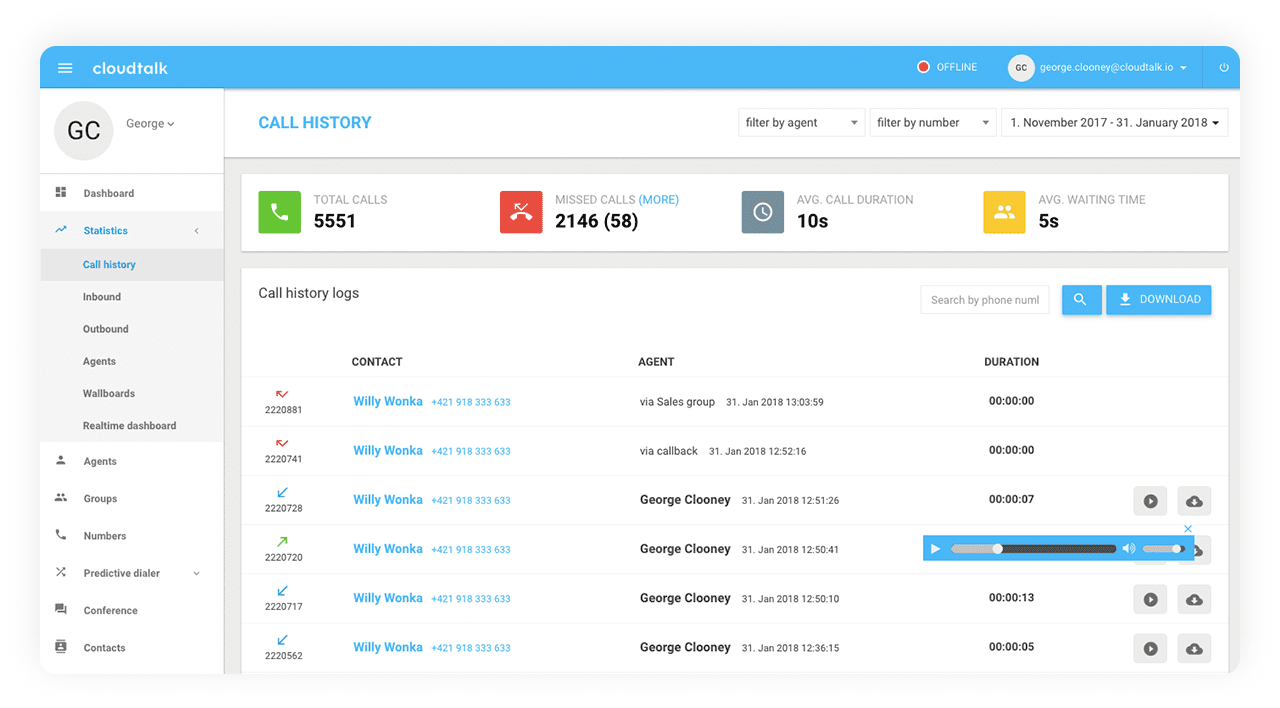
CloudTalk is a cloud-based call center solution that’s particularly popular among European businesses thanks to its strong presence in the EU market. With a G2 rating of 4.4/5, users highlight its advanced reporting, intelligent call routing, and intuitive design. The main drawback is occasional integration issues and higher pricing tiers for advanced features.
Key features:
- Smart call routing
- IVR customization
- Real-time and historical reporting
- Call recording and monitoring tools
Best for: SMBs in Europe or globally distributed teams that need robust analytics and call routing.
Strengths: Strong reporting, reliable EU infrastructure, and user-friendly design.
Limitations: Pricier advanced plans, integration bugs.
11. JustCall
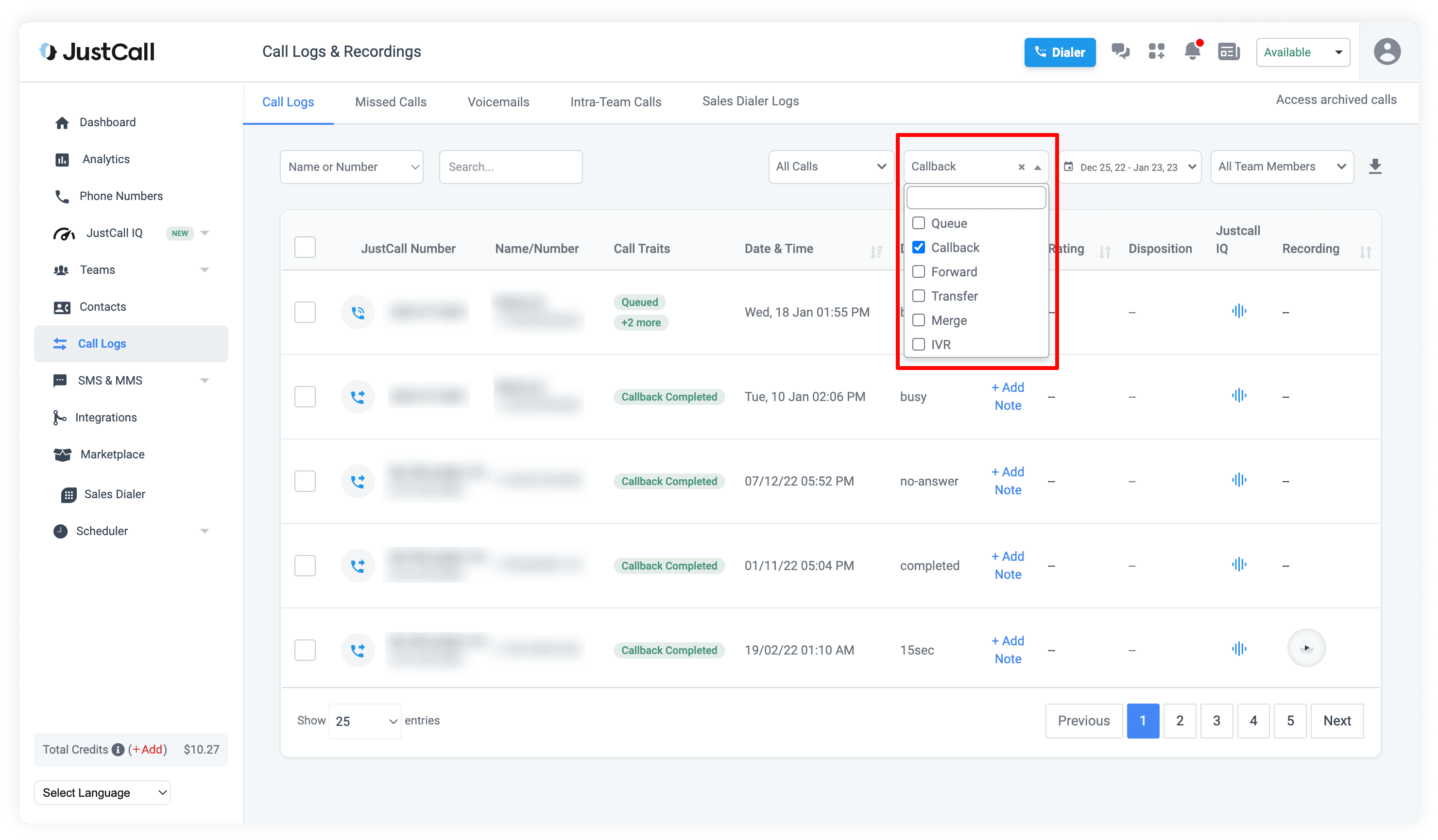
JustCall is designed for distributed and remote teams, providing a diverse VoIP and call center platform with great integration capabilities. With a G2 rating of 4.3/5, users value its seamless sync with CRMs like Salesforce and help desks like Zendesk, as well as its straightforward setup. However, reviews mention occasional bugs with the mobile app and limited analytics depth compared to larger platforms.
Key features:
- SMS automation
- Call monitoring, whisper, and barging
- Analytics dashboards
- Click-to-call and browser extension tools
Best for: Remote or distributed teams that need deep CRM and help desk integration.
Strengths: Easy CRM integration, remote-friendly, quick setup.
Limitations: Mobile app performance issues, limited advanced analytics.
12. Ringover
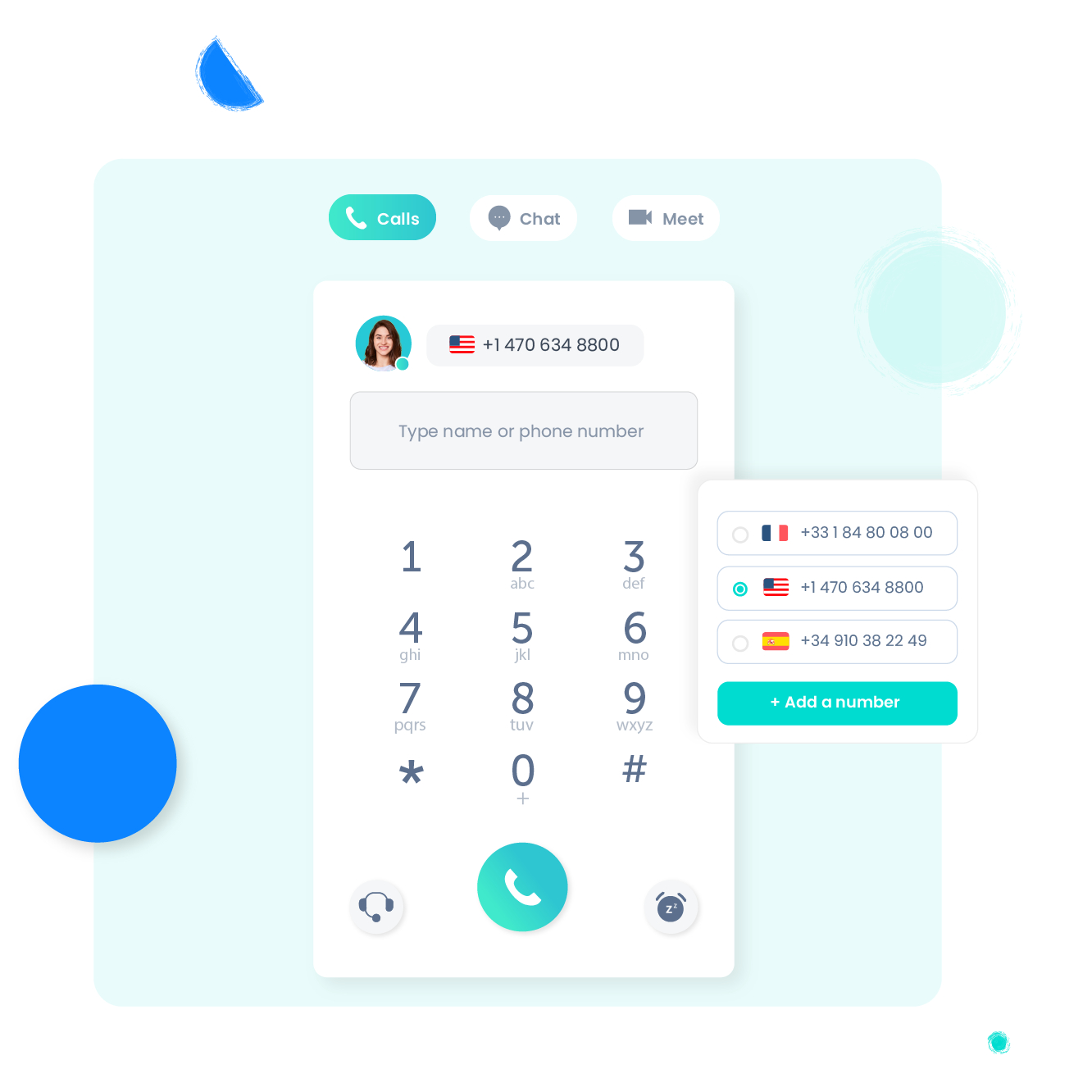
Ringover provides a cloud-based communication platform with a focus on collaboration and productivity. With a G2 rating of 4.6/5, it’s praised for its clean interface, strong infrastructure, and team-friendly features like shared call logs and real-time dashboards. On the downside, some users note occasional glitches with reporting exports and fewer advanced AI features compared to enterprise providers.
Key features:
- Real-time performance dashboards
- Team collaboration features (shared call logs, notes)
- Call recording, monitoring
Best for: Collaborative teams that need reliable communication.
Strengths: User-friendly, strong collaboration, reliable infrastructure.
Limitations: Reporting glitches, limited AI functionality.
13. Vonage
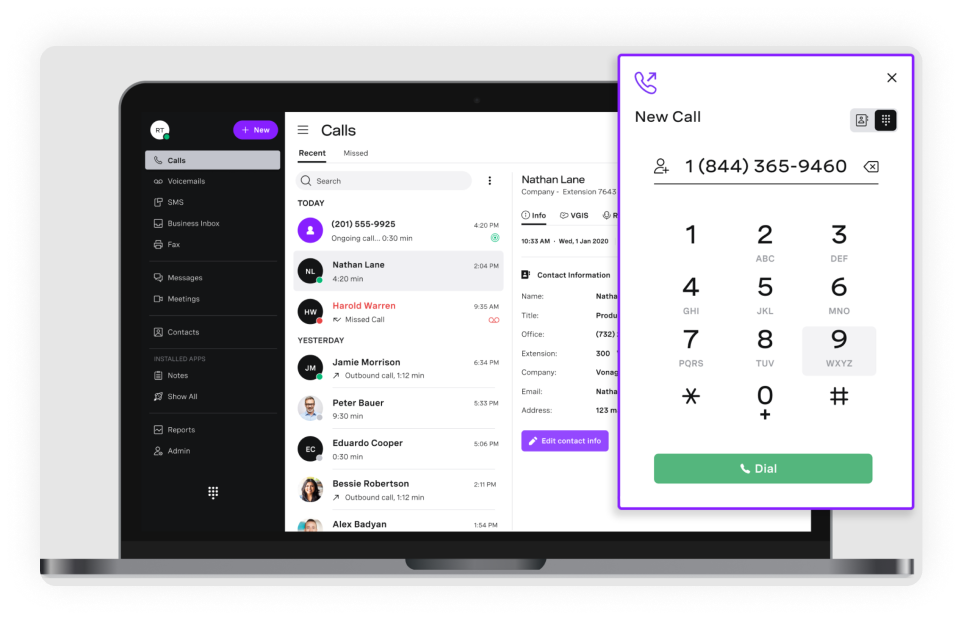
Vonage offers a modern communication platform with unlimited calling and texting, making it ideal for small to mid-sized businesses that want both affordability and flexibility. With a G2 rating of 4.3/5, users appreciate its wide global coverage and API-driven customization that allows businesses to tailor workflows. Some users report occasional downtime and customer support delays.
Key features:
- API-based customization with UCaaS/CPaaS mix
- Video meetings
- Call recording, routing, and monitoring
Best for: SMBs and mid-sized businesses that need flexible APIs and affordable communication.
Strengths: Affordable, flexible, API-driven, modern design.
Limitations: Customer support delays, occasional downtime.
14. NICE
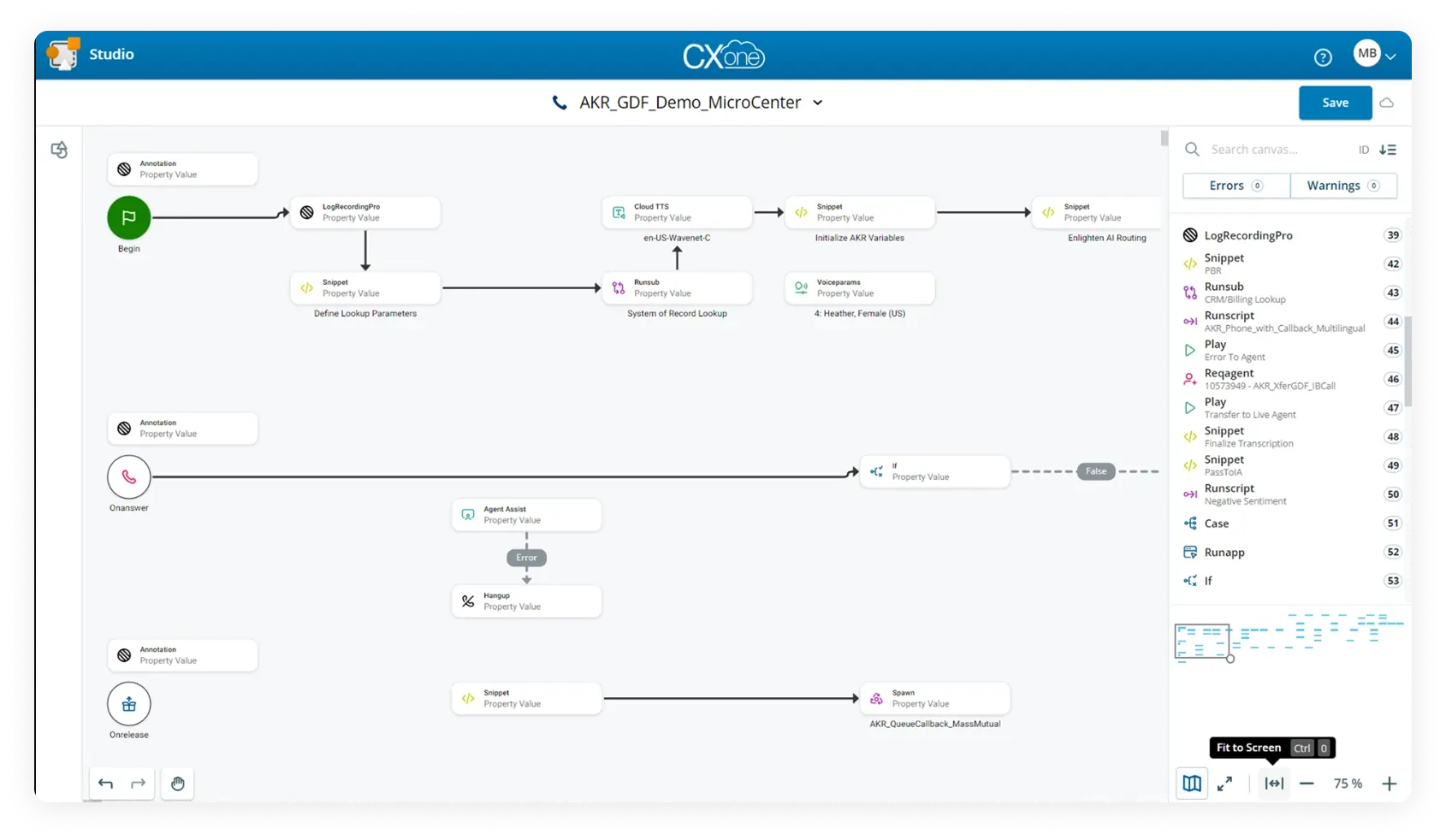
NICE is an enterprise-level call center software solution designed for large organizations that prioritize customer experience at scale. With a G2 rating of 4.3/5, users value its powerful analytics, AI-driven automation, and management tools. However, reviews note a steep learning curve and higher implementation costs compared to SMB-focused solutions.
Key features:
- Omnichannel routing
- Quality management
- Compliance tools
- Automation for repetitive customer service tasks
Best for: Large enterprises looking for AI-based insights and advanced workforce optimization.
Strengths: Scalable, powerful analytics, comprehensive workforce tools.
Limitations: Expensive, steep learning curve.
15. Five9
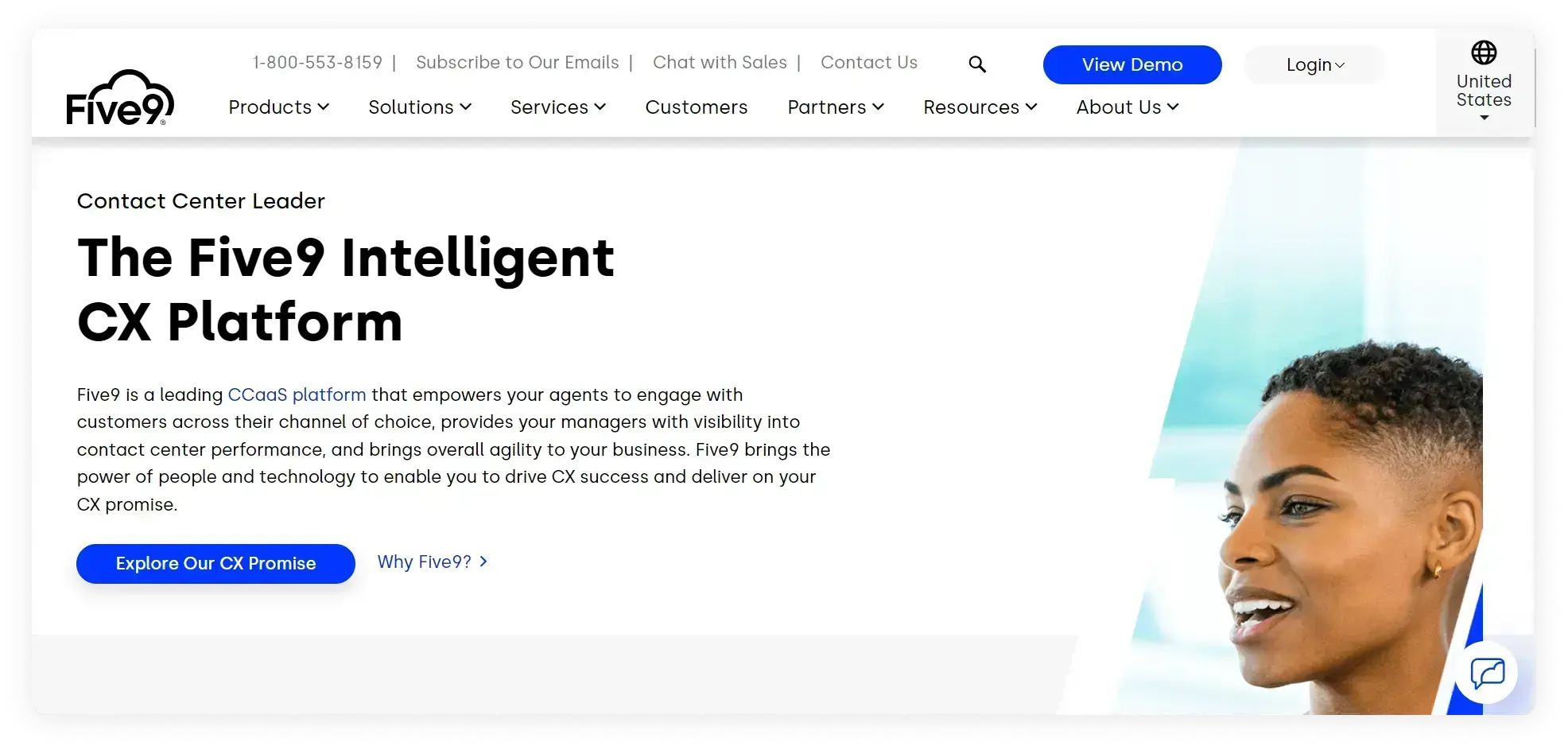
Five9 is a leading cloud contact center software known for enterprise reliability and AI-enhanced automation. With a G2 rating of 4.1/5, users highlight its intelligent routing, virtual agent capabilities, and flexibility for both inbound and outbound campaigns. It’s widely praised for uptime and scalability, but criticized for a complex onboarding process and premium pricing.
Key features:
- Intelligent call routing
- AI-powered virtual agents
- Omnichannel support
- Real-time analytics
Best for: Enterprises that need a scalable, AI-driven contact center platform.
Strengths: Strong AI features, enterprise scalability, and reliable uptime.
Limitations: Higher pricing, complex onboarding.
How to choose the right call center software solution
Choosing the right call center software (and compatible phone systems) means matching product capabilities to clear business goals, including support models, channels, agent workflows, and growth plans. Use this step-by-step framework to evaluate vendors and select a solution that fits your operations.
1. Map out business goals to call center software features
Begin by defining what you want to achieve:
- Reduce wait times → Automatic call routing and IVR
- Improve customer satisfaction → CRM integration
- Increase outbound sales → Predictive dialers and campaign tools
- Boost agent performance → AI dashboards and reporting
2. Evaluate integrations and mobile applications
Verify native integrations with your help desk, CRM, ticketing, and collaboration tools. Confirm API availability for custom connectors. Test vendor mobile apps for call quality, data sync, push notifications, and offline behavior so remote agents can stay productive.
3. Compare vendor framework (cost, support, uptime, roadmap)
Compare vendors on consistent benchmarks:
- Cost: subscription, setup, add-ons, per-seat vs usage fees .
- Support: onboarding, training, dedicated CSM, SLA response times.
- Uptime: SLA percentage, historical incident reports, and failover options.
- Roadmap: planned features, AI investments, security updates
4. Calculate the total cost of ownership and ROI
Include implementation, training, integrations, admin time, and migration risk in TCO. Estimate ROI from reduced AHT, higher CSAT, and lower agent churn. Run a 90-day pilot to validate assumptions and measure impact on KPIs.
5. Take into account industry-specific considerations
Account for compliance (HIPAA, PCI, GDPR), multilingual IVR, data residency, peak-season scaling, and required audit trails or reporting.
Call center software implementation roadmap
Implementing call center software is not just about installing new technology; it’s about creating a structured rollout that minimizes disruption, improves customer service, and supports workforce management. A clear roadmap allows businesses to move step by step, ensuring long-term success and adoption.
Discovery and call-flow design
Every successful implementation begins with understanding customer needs. At this stage, companies map out routing features, IVR menus, and escalation paths that reflect real use cases. Designing call flows in advance ensures both customer service teams and IT stakeholders are aligned.
Document call flows visually before building them in the call center system.
CRM integration and data migration
Once workflows are defined, the next step is to integrate the call center software with your CRM. This integration gives agents a unified view of customer history, making interactions faster and more personal. Before migration, data should be cleaned, duplicates removed, and integration points tested to avoid errors.
Run a staged migration to validate CRM integration before going live.

“The tool you select for outbound calling should support adaptive dialing speed, intelligent load distribution, and integration with CRM systems. Integration with CRM helps personalize communication with contacts, while adaptive dialing speed and intelligent load distribution will ensure an even workload on your agents throughout the day, which in turn will positively affect their well-being and prevent burnout.”
– Nickolai Kalinin, Product Manager at MightyCall
Mobile and remote agent setup
Today’s call centers often rely on mobile applications and remote workforces. Setting up secure access for these teams is essential. Organizations should establish Bring Your Own Device policies, implement VPN security, and ensure compliance with data protection regulations. This guarantees remote agents can handle virtual calls consistently.
Pilot test mobile apps on different devices to confirm compatibility.
Agent training, QA, and adoption
Agent training is critical to success. Comprehensive onboarding programs should cover software navigation, call recording, scripting, and escalation handling. Pair training with quality assurance processes to monitor calls and maintain standards. Engagement techniques such as gamification and feedback loops can boost adoption rates.
Record live training sessions so agents can revisit them anytime in the software portal.
Ongoing optimization and service administration
After implementation, continuous improvement ensures long-term success. Monitor KPIs such as average handle time, first-call resolution, and customer satisfaction. Regularly adjust call routing, update scripts, and refine training based on performance insights. Ongoing administration keeps the phone system aligned with evolving business needs.
Schedule quarterly reviews to keep your call center software evolving with customer expectations.
Measuring success: KPIs and ROI
To understand whether call center software and systems deliver value, businesses must track performance through clear metrics. Measuring customer satisfaction, agent productivity, and operational efficiency provides a direct link between technology investments and ROI. Well-defined KPIs also help identify gaps and guide continuous improvement.
Customer service KPIs
The effectiveness of call center software in customer service depends on how well it strikes a balance between speed, quality, and experience. Commonly tracked KPIs include first call resolution, average handle time, call abandonment rate, and queue time. These indicators help managers evaluate efficiency while monitoring customer satisfaction.
| KPI | Definition | Why it matters | Benchmark |
|---|---|---|---|
| First Call Resolution (FCR) | Resolved calls on first contact ÷ total calls | Reduces repeat calls and increases customer satisfaction | 70–75% is considered strong |
| Average Handle Time (AHT) | (Talk time + Hold time + After-call work) ÷ total calls | Balances efficiency with service quality | 6 minutes average |
| Call Abandonment Rate (CAR) | Abandoned calls ÷ total inbound calls | Highlights wait-time frustrations | Under 5% |
| Queue Time | Total wait time ÷ number of calls | Shorter queues improve customer service perception | Less than 2 minutes |
Sales metrics in call center software
For outbound and blended centers, success is measured by sales-oriented metrics. Evaluating hit rates, conversion rates, and cost-per-contact ensures that solutions maximize return while minimizing wasted effort. These KPIs are vital for comparing campaign effectiveness and aligning strategy with sales targets.
| Metric | Formula | Why it matters |
|---|---|---|
| Hit rate | Connected calls ÷ total dials | Shows the efficiency of the dialing strategy and data quality |
| Conversion rate | Sales ÷ connected calls | Benchmark: 10–15% in many industries; higher means better targeting |
| Cost-per-Contact | Total campaign cost ÷ successful contacts | Critical for budgeting and proving ROI in call center operations |
Voice of customer insights and feedback loops
Tracking hard numbers alone is not enough. Feedback loops and qualitative insights provide context for metrics, helping to improve overall call center solutions and software performance.
- Surveys: Post-call or email surveys measure customer satisfaction and Net Promoter Score.
- QA reviews: Supervisors evaluate recorded calls for tone, compliance, and problem-solving quality.
- Sentiment analysis: AI tools process transcripts and gauge emotions in customer interactions.
- Focus groups: Small groups of customers provide qualitative feedback on pain points.
- Continuous loops: Insights are fed back into training, routing adjustments, and script improvements to close performance gaps.
Future trends in call center software
The call center industry is undergoing a significant transformation, led by advancements in technology and changing customer expectations. By 2027, most call centers will probably use these innovations to enhance efficiency, improve customer satisfaction, and reduce operational costs.
Generative AI and copilots
By 2027, most call centers will integrate generative AI copilots to assist agents in real-time. These AI-based tools can suggest responses, summarize customer interactions, and provide recommended actions, allowing agents to handle inquiries more efficiently. For instance, Microsoft’s Copilot for Service is already helping businesses deploy AI assistants to support customer service operations.
Additionally, Verizon’s deployment of Google’s AI assistant has led to a nearly 40% increase in sales, as it allows customer service representatives to respond more quickly to inquiries.
Predictive routing and analytics
By 2027, most call center systems will most likely use predictive routing and analytics to increase and improve customer experience. Predictive routing uses historical data and AI algorithms to connect customers with the most suitable agent, reducing wait times and improving first-call resolution rates.
Analytics platforms will provide insights into customer behavior, enabling proactive support and personalized service. Research by Invoca highlights the importance of predictive analytics in spotting issues before they impact customers, thereby enabling proactive support that builds loyalty and boosts revenue.
Unified communications and mobile-first service
By 2027, most call centers will most likely adopt unified communications (UC) platforms and mobile-first strategies to support remote and hybrid work environments. UC platforms integrate various communication channels, such as voice, chat, and video, into a single interface, facilitating seamless collaboration among agents and teams.
A mobile-first approach ensures that agents can access these platforms from smartphones and tablets, providing flexibility and improving response times. According to Sipcom, businesses are increasingly adopting UC solutions to enhance collaboration and streamline communication processes.
Common pitfalls to avoid
Without all the necessary information in your hands, you’re bound to make certain mistakes. However, there are common pitfalls you can definitely avoid.
Overbuying channels and unnecessary add-ons
Problem: Many call centers invest in software with multiple communication channels and add-ons they don’t actually need.
Why it matters: Extra channels increase costs, complicate workflows, and can overwhelm agents who don’t have the capacity to manage them effectively.
Solution: Conduct a careful needs assessment before purchasing. Focus on the channels your customers actually use and choose scalable add-ons that can be activated as your operations grow.
Underestimating change management
Problem: Organizations often overlook the human side of implementing new call center software, assuming employees will adapt automatically.
Why it matters: Lack of proper training and resistance to change can lead to low adoption rates, errors, and inefficiencies, undermining the software’s benefits.
Solution: Develop a structured change management plan, including staff training, clear communication, and phased rollouts to ensure smooth adoption and employee buy-in.
Weak SLA and uptime commitments in call centet software
Problem: Some solutions come with vague or minimal Service Level Agreements, offering low guarantees for uptime and support.
Why it matters: Downtime directly impacts customer experience and can lead to lost revenue, frustrated agents, and reputational damage.
Solution: Choose call center software vendors with clear SLAs and high uptime guarantees. Ensure support channels are responsive and include penalties for non-compliance to protect your operations.
Enjoy the competitive advantage of modern call center platforms
Modern call center platforms are no longer just about answering phones; they’ve become a secret weapon for businesses that want to outrun the competition. With call center software handling everything from inbound and outbound calls to performance tracking and agent productivity, companies can deliver faster, smarter, and more personal customer service while trimming down costs.
Choosing the right solution isn’t just about ticking requirement boxes; it’s about finding a platform that grows with you. The best systems help teams cut response times, track what really matters, and keep customer experiences consistent across every channel. Business leaders should focus on scalability and smart integrations to stay ahead in today’s fast-changing service landscape.







